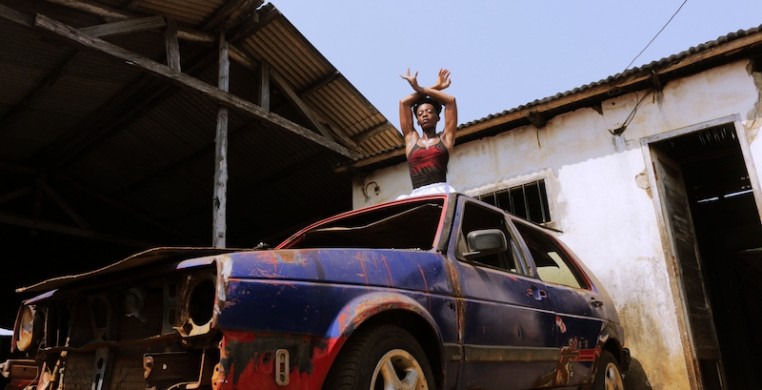Participating as both a writer and virtual audience member of the 23rd Annual JOMBA! Contemporary Dance experience left me seated with a lot of questions. I believe this is a great way to conclude a festival, or any interaction with art. There is something enticing about dangling threads waiting to be pulled; loose ends can feel much more satisfying than answers.
In the position of writer/dancer, I remain curious about my role: to whom does my responsibility lie? Are dance writers micro-historians? Are we documentarians? Can we be part of the art? In the case of this year’s JOMBA! festival specifically, I was left pondering the many possible ways there may be to cross borders within dance writing.
Questions continued to arise. Strings continued to dangle. So, I pulled on one.
Aïda Colmenero Dïaz created an ideal springboard for experimental response with her ongoing project, “She Poems,” which closed out this year’s digital festival. The series of seven short films, created in conjunction with female dancers from across the African continent, represented eight years of partnerships focused on highlighting individual performers and environments in a well-conceived compositional challenge to the ever-present colonialist misrepresentation of Africa as a monolithic entity.
At the top of the program, Dïaz invited audience members to watch the dances, each of which was inspired by a poem, through the lens of the viewer’s own experiences and sensations. I think this early framing was essential in giving watchers a pathway to become more than voyeurs. Coming from my own experience as a woman, having a female body has frequently come with experiences of being gazed upon, inspected, evaluated and commented at. For Black female bodies, I’m sure this truth is exponentially exacerbated.
Here, I was left questioning what it might mean for me as a writer to let go of the evaluative lens and experience the films authentically without falling into surgical levels of scrutiny. I found myself thoroughly wrapped up in the beauty of sweat, the multiple implications of breath and the many ways in which the human body can grow something new out of poetry. It was in this last noticing that I caught sight of the thread I was interested in unraveling.
After watching these women dance with the understanding that poetry served as their source material, I felt compelled to return to poetry to process my own responses to the dancing. Here are the seven windows that were opened for me, an American woman, as I watched the seven films produced by a Spanish woman and performed by Tanzanian, South African, Senegalese, Cape Verdian and Togolese women.
Window 1: In response to “Exodus”
It’s 5 o’ clock. The street is on fire again.
The people go about their day
Again.
There is little concern reserved for the burning.
Everyone here has seen this before.
Give it a while.
In time, they wager, she will burn
Herself out.
Fire danger - Low today.
It’s long been established that self-contained fires
Remain curiosities rather than threats
At least to start.
Avoidable orbits if they
Keep their distance.
Visitors arrive.
There are always extra visitors when there’s smoke.
Some remember their own burnings.
The children look on with fascination.
One girl brings a stick
With a marshmallow up to the flames
White sugar ballooning
Beckoned by heat.
Tough skin does its best to protect
Molten sweet centers.
A slight miscalculation,
Scorched sugar sticks to the roof
Of her mouth.
A story. She wants to tell a story.
“When I grow up, I hope my flames are yellow.”
Window 2: In response to “Fear”
For once, I climbed the things that were not soft. Until now, I had been expected to hold only pillows and fall upon feathered things. Better yet, to not fall at all. This advice was a mistake. The world is not made of cotton or clouds. As it turns out, we live upon sharp ground. My bones would have done better to learn how to catch me sooner.
Window 3: In response to “Life”
The horse has seen
Too
Many things.
He may stay.
He cannot speak.
The screams still
Wring out.
Where the rocks cover disgrace,
Today the soil is brown.
Yesterday, it was red.
There are not enough buckets.
Wash. Rinse.
Flood.
Intention is past tense.
The stain is permanent.
The horse does not know
One day, soon
It will be his turn.
They will come
Extending a carrot
And pet
Him gently.
When there is nowhere
Left to run.
Window 4: In response to “The Fear Remover”
You’ve found me at last! I must admit, I’m surprised it took you so long with the fanfare of lighthouses and fog horns piercing the night. Was it the reflection of sweat and oil that finally caught your search light? I’m baking beneath the surface of my own skin.
May I direct the light for you?
It seems you bought your ticket to revive me too late. I’ve sold out the front row to myself. The whole orchestra section, in fact. All I ask now is that you relax your eyes and allow only breath rather than the rush of words ready to roll off your tongue to escape your lips. I want to listen. It’s hard to hear while I’m treading time to keep my own thoughts above water. Wait and I will tell you how I came to raise my hands to survival and declare that shallow marrow had no right to claim my floating hair or furious feet.
Kindly, tilt the light a little more to the left?
The darkest part of my face is my best side. It pollutes greed most potently. Guilt. Gilt. All we have left now. You are still wondering how I am here. I don’t blame you. The water can look suspicious from above. I learned long ago how to swim for myself. There were many places to practice — puddles, a bathtub, out in the monsoon.
I was lost for days once. A woman named Ingrid found me beneath her sink trying to understand the life of a pipe. We, too, have the capacity to filter the discards of hands and feet and the longest night, without drowning. It was the listening that took days. I needed to listen.
It’s only hard to fathom how I’m still above the surface if you’ve tuned out what the world is saying and everything you see shines five volumes too bright.
Window 5: In response to “Cicatriz De Luz”
Militant hopscotch requires a grenade instead of a stone.
Don’t worry.
It won’t explode, but I might.
Picking out this dress took too long.
There are marks on the sleeves.
My best friend traced me on the sidewalk in pastel purple chalk.
Perhaps someone will walk by a 2-D me tomorrow.
Maybe they will think I was a boy.
Maybe they won’t think anything at all.
Maybe there won’t be a “they” to walk by.
The forecast says it might rain.
That would wash the outline away.
Rain knows how to mix wrath and mirth like that.
Red and blue make purple.
Mirth and wrath make rain.
Rain will wreck my dress.
I looked very pretty when I left the house.
I look even prettier with my teeth bared.
Window 6: In response to “Abyss”
A quiet place
Can be quite a loud place.
Only a calm overseer
Can manage silent screams.
Window 7: In response to “Lifetimedust VII”
Nothing
Knows how
To sweep
The past
Along as
Well as
A pair of
Hands.
Even the Gaps
Between Fingers
Disagree With Distances
Between
Memories.
Knuckles
Keep track
Of time
Differently
From one
Another.
On the day
My
Grandmother
Walked away
She left
With her
Arms full
Of sand
And her
Fists reversed
Open palms.
Open lines.
She was never
Afraid of the creases
In her hands that were
Supposed to dictate when
Her time might be up.
They grew deeper as she aged.
“When I go to the sun,”
She would say,
“I will take the ground
With me.”
That morning I wondered
Why the floor was so smooth
And how the walls had managed
To wail their white paint right off.
I lifted my hand to my eyes and felt
The spot on my right temple in which
My own story lines started to sink in.
--
The JOMBA! Contemporary Dance Experience took place from Aug. 24-Sept. 5. Performances will be accessible on the JOMBA! website until the end of September. For more information and to access the performances, visit jomba.ukzn.ac.za.

2021 Critical Dance Writing Fellow Jennifer Passios is an artist-athlete, wordsmith, and dance educator powered by improvisation. Over the past 7 years, Jen has performed throughout the United States enlivening spaces from stages to sand dunes. She made her on screen debut in 2019 as a principal dancer in the feature length film “Little Women” (Columbia Pictures) and recently completed a 10 month long DIY dance road trip alongside CoGRAVITY counterpart Jacob Regan. When she isn’t dancing, Jen spends much of her time with an espresso in one hand, and a pen in the other. Her musings can be found at thINKingDANCE, on her personal blog FIELD NOTES, in the Instagram ether via her crowdsourced poetry project #AllRequestTuesday, and under the eyes of grant evaluators across 6 time zones. She enjoys using her voice in service of artistic advocacy with a particular focus on leadership pathways for women and girls.

